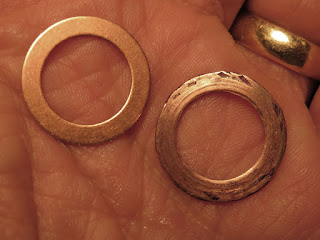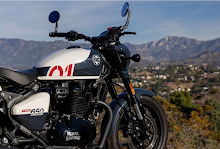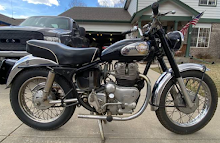 |
| The owner's manual says my 1999 Royal Enfield Bullet motor holds about 2.25 quarts of oil. But I only got 1.75 quarts of dirty oil when I drained the motor and oil filter housing. |
Changing the oil is the most basic maintenance task I perform for my old-fashioned iron barrel 1999 Royal Enfield Bullet. It's easy! Right?
Yeah, well, no, it's not easy.
I've always made it somewhat easier on myself by changing the oil when the motor is cool. (I live in Florida, so my Bullet motor is always at least warm, never really cold.) I always let the oil drain a long time to make sure as much dirty oil as possible exits the motor.
But I recall that, years ago, we were always advised to change oil when a motor is hot. It flows faster, we were told. Would fast-exiting hot oil carry away more dirt than a slow stream of cold oil? Maybe. But the real reason probably was just to save time for the mechanic.
This now probably obsolete advice inspired me to try it that way this time; for variety if nothing else.
The fun part of this procedure was going for a run to heat up the engine. I picked a lightly travelled open road and twisted the throttle. Wheee! OK, that's done. After the run I noted that the oil level shown on the dipstick was a little less than half way to the "Full" mark.
Now to undo the two drain plugs at the bottom of the motor. These plugs have suffered from the many times I've opened them in the past, so no socket size in my collection fits either of them well anymore.
This encouraged me to use my fingers rather than a tool to finish undoing the first plug as soon as it would turn.
Ouch! That's hot. So, to undo the next plug I first donned a heavy gardening glove. Heat was now no problem but the instant stream of oil running out soaked the fingers of the glove.
Worse, I then dropped the plug into the basin full of hot dirty oil gathering under the motor. I instinctively reached in — with the glove on — to retrieve it. Decidedly messy.
Once burned, I now decided to let the motor cool thoroughly before attempting to remove the oil filter from its housing near the exhaust down pipe.
With the oil filter eventually removed, I opened the package of a new oil filter. They come wrapped in plastic. I cut one end of this plastic wrapping open and poured in my favorite oil, Castrol 20W-50. With the new filter now saturated with fresh oil I shoved it into the housing as the dripping oil filter lubricated my fingers with oozing oil. What a mess. I closed up the housing.
Next step was to replace the drain plugs in the motor before adding oil. But first...
Two things: I wanted to buy fresh copper crush washers to replace the worn items sealing my engine plugs against oil leaks. I also wanted to measure the amount of old oil I had drained from the engine.
Why? Because no one seems to agree how much new oil an old Bullet should get in an oil change. In part it's the old "every Bullet is different" argument. In part it's the fact that the dip stick isn't much help in the dry sump motor because until the motor runs to distribute oil throughout the motor the amount in the oil tank is almost irrelevant.
And then there are the owners, some of whom insist on shaking the motorcycle from side to side and undertaking other measures (rags on sticks down the filler spout to soak up residual oil!) to get every last bit of old oil out.
And, finally, I am an American.
For me, oil comes in quarts. Not liters. So being told how much oil I need in liters is confusing, even though I know quarts and liters are close to the same size. The owner's manual says the oil capacity of the 500cc Bullet is 2.25 liters (exactly the same amount specified for the 350cc version). That's a little less than 2.5 quarts.
I know from experience that if I try to pour that much oil into my old Royal Enfield Bullet the oil reservoir will overflow! It's obvious that some considerable amount of old oil remains in the motor no matter what I do to get it out. But how much?
I used an old gallon milk jug marked in quarts to determine that the dirty oil I obtained from the motor and the oil filter housing together amounted to only a bit more than 1.5 quarts!
Rocking the motorcycle side-to-side and back-and-forth with the drains open produced a small additional amount of oil. Eventually I got 1.75 quarts of dirty oil out of the motor. So that is the amount I planned to put back into the motor once I got the plugs back in.
But first the washers. Trips to three parts outlets failed to yield copper crush washers of exactly 9/16th-inch interior dimension with an exterior dimension of roughly 13/16ths of an inch. Lucky for me I have a brother who does his own work on cars. He found a couple washers of the right interior dimension and approximate exterior dimension and mailed them to me. Lovely.
With the new washers in place and the plugs buttoned up I added my 1.75 quarts of 20W-50 Castrol. The dipstick showed that the oil reservoir was now well over the "full" mark. I have no doubt that once the motor has run the level on the dipstick will drop back to a proper mid-stick level.
By the way, "quart" is a Medieval English term, derived from the French for "quarter." However, Canadian French speakers use "pinte" to mean what English speakers call a "quart," while English (Imperial) quarts are different than U.S. quarts and, in the U.S., we have both liquid quarts and dry quarts and they are not the same.
I've always made it somewhat easier on myself by changing the oil when the motor is cool. (I live in Florida, so my Bullet motor is always at least warm, never really cold.) I always let the oil drain a long time to make sure as much dirty oil as possible exits the motor.
But I recall that, years ago, we were always advised to change oil when a motor is hot. It flows faster, we were told. Would fast-exiting hot oil carry away more dirt than a slow stream of cold oil? Maybe. But the real reason probably was just to save time for the mechanic.
This now probably obsolete advice inspired me to try it that way this time; for variety if nothing else.
The fun part of this procedure was going for a run to heat up the engine. I picked a lightly travelled open road and twisted the throttle. Wheee! OK, that's done. After the run I noted that the oil level shown on the dipstick was a little less than half way to the "Full" mark.
Now to undo the two drain plugs at the bottom of the motor. These plugs have suffered from the many times I've opened them in the past, so no socket size in my collection fits either of them well anymore.
This encouraged me to use my fingers rather than a tool to finish undoing the first plug as soon as it would turn.
Ouch! That's hot. So, to undo the next plug I first donned a heavy gardening glove. Heat was now no problem but the instant stream of oil running out soaked the fingers of the glove.
Worse, I then dropped the plug into the basin full of hot dirty oil gathering under the motor. I instinctively reached in — with the glove on — to retrieve it. Decidedly messy.
Once burned, I now decided to let the motor cool thoroughly before attempting to remove the oil filter from its housing near the exhaust down pipe.
With the oil filter eventually removed, I opened the package of a new oil filter. They come wrapped in plastic. I cut one end of this plastic wrapping open and poured in my favorite oil, Castrol 20W-50. With the new filter now saturated with fresh oil I shoved it into the housing as the dripping oil filter lubricated my fingers with oozing oil. What a mess. I closed up the housing.
Next step was to replace the drain plugs in the motor before adding oil. But first...
Two things: I wanted to buy fresh copper crush washers to replace the worn items sealing my engine plugs against oil leaks. I also wanted to measure the amount of old oil I had drained from the engine.
Why? Because no one seems to agree how much new oil an old Bullet should get in an oil change. In part it's the old "every Bullet is different" argument. In part it's the fact that the dip stick isn't much help in the dry sump motor because until the motor runs to distribute oil throughout the motor the amount in the oil tank is almost irrelevant.
And then there are the owners, some of whom insist on shaking the motorcycle from side to side and undertaking other measures (rags on sticks down the filler spout to soak up residual oil!) to get every last bit of old oil out.
And, finally, I am an American.
For me, oil comes in quarts. Not liters. So being told how much oil I need in liters is confusing, even though I know quarts and liters are close to the same size. The owner's manual says the oil capacity of the 500cc Bullet is 2.25 liters (exactly the same amount specified for the 350cc version). That's a little less than 2.5 quarts.
I know from experience that if I try to pour that much oil into my old Royal Enfield Bullet the oil reservoir will overflow! It's obvious that some considerable amount of old oil remains in the motor no matter what I do to get it out. But how much?
I used an old gallon milk jug marked in quarts to determine that the dirty oil I obtained from the motor and the oil filter housing together amounted to only a bit more than 1.5 quarts!
Rocking the motorcycle side-to-side and back-and-forth with the drains open produced a small additional amount of oil. Eventually I got 1.75 quarts of dirty oil out of the motor. So that is the amount I planned to put back into the motor once I got the plugs back in.
But first the washers. Trips to three parts outlets failed to yield copper crush washers of exactly 9/16th-inch interior dimension with an exterior dimension of roughly 13/16ths of an inch. Lucky for me I have a brother who does his own work on cars. He found a couple washers of the right interior dimension and approximate exterior dimension and mailed them to me. Lovely.
 |
| New washer, left, knackered washer center, wedding ring, right. |
By the way, "quart" is a Medieval English term, derived from the French for "quarter." However, Canadian French speakers use "pinte" to mean what English speakers call a "quart," while English (Imperial) quarts are different than U.S. quarts and, in the U.S., we have both liquid quarts and dry quarts and they are not the same.






















No comments:
Post a Comment